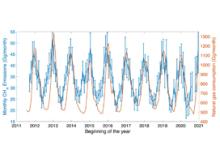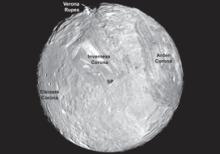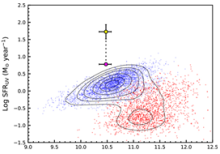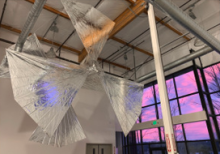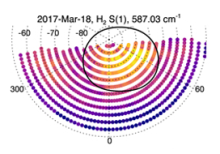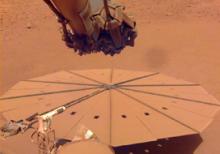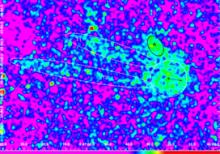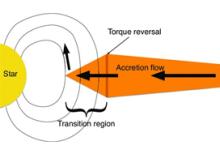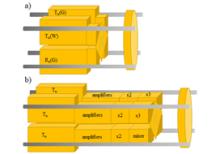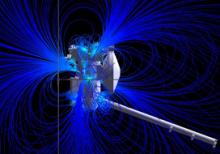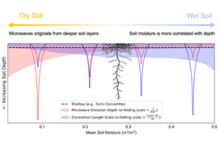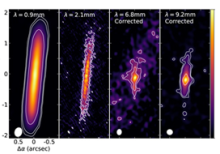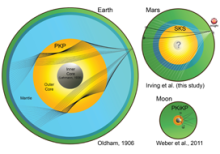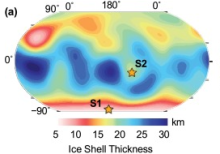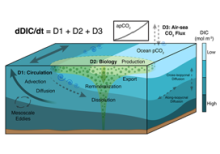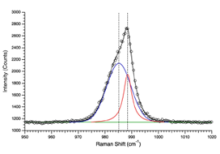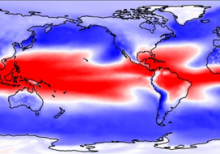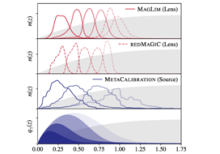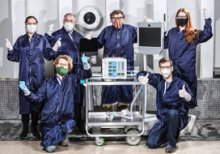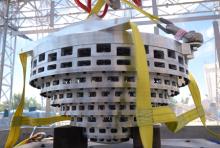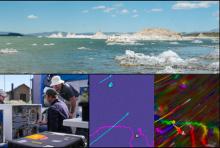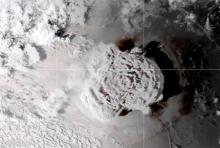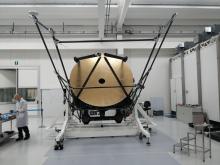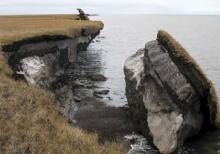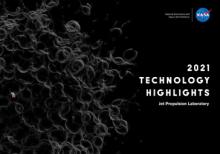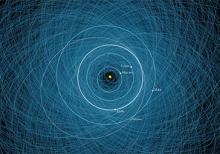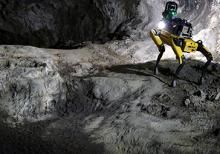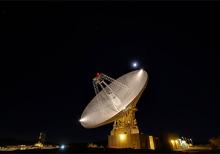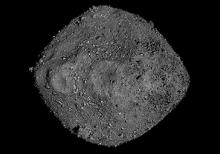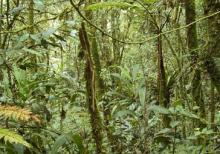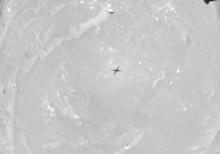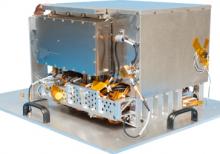The Media Relations Office at JPL is responsible for issuing press releases and hosting media events. As an institution, discussing new discoveries with the public is key to JPL's success as an institution. Below are selected press releases from JPL about new advances in many research fields.
News Board
Decadal decrease in Los Angeles methane emissions is much smaller than bottom-up estimates
Unraveling the Geologic History of Miranda's Inverness Corona
Investigating permafrost carbon dynamics in Alaska with artificial intelligence
Discovery of a Low-redshift Hot Dust-obscured Galaxy
Io’s polar volcanic thermal emission indicative of magma ocean and shallow tidal heating models
Forest productivity recovery or collapse? Model-data integration insights on drought-induced tipping points
A High Spatial and Spectral Resolution Study of Jupiter's Mid-infrared Auroral Emissions and Their Response to a Solar Wind Compression
The Nitty-Gritty Forces That Shape Planetary Surfaces
Contrasting Intraurban Signatures of Humid and Dry Heatwaves over Southern California
Faint but Not Forgotten. I. First Results from a Search for Astrospheres around AGB Stars in the Far-ultraviolet
Halting migration in magnetospherically sculpted protoplanetary discs
Dual-band Fourier-transform Millimeter-wave Spectrometry for In Situ Gas Sensing
Magnetic Field Modeling and Visualization of the Europa Clipper Spacecraft
Remotely Sensed Soil Moisture Can Capture Dynamics Relevant to Plant Water Uptake
Modest Dust Settling in the IRAS04302+2247 Class I Protoplanetary Disk
First observations of core-transiting seismic phases on Mars
The co-production of knowledge for climate science
Prebiotic reactions in a Mars analog iron mineral system: Effects of nitrate, nitrite, and ammonia on amino acid formation
Estimating the 3D structure of the Enceladus ice shell from Flexural and Crary waves using seismic simulations
Attribution of Space-Time Variability in Global-Ocean Dissolved Inorganic Carbon
Crystallization Kinetics of Vitreous Magnesium Sulfate Hydrate and Implications for Europa's Surface
A Physical Explanation for Ocean Air-Water Warming Differences Under CO2-Forced Warming
Joint analysis of Dark Energy Survey Year 3 data and CMB lensing from SPT and Planck. III. Combined cosmological constraints
JPL-developed technologies, including VITAL, FINDER, 3D-printing methods, and Voyager spacecraft communications, are featured in the agency’s technology publication.
Like a car’s crumple zone, the experimental SHIELD lander is designed to absorb a hard impact.
A team at the Lab has invented new technologies that could be used by future missions to analyze liquid samples from watery worlds and look for signs of alien life.
The huge amount of water vapor hurled into the atmosphere, as detected by NASA’s Microwave Limb Sounder, could end up temporarily warming Earth’s surface.
Telescopes designed to operate in space have to be constructed differently than those meant to operate on the ground. But what about telescopes that operate in between?
A concept in development at NASA’s Jet Propulsion Laboratory would allow potential planetary missions to chase interesting clues in subsurface oceans.
To assess how climate warming will change risks such as crop failures and wildfires, it’s necessary to look at how the risks are likely to interact.
Part of an ongoing project to grow the capacity of the Deep Space Network, which acts as a kind of interplanetary switchboard, the new antenna is the network’s 14th.
Scientists are turning to a combination of data collected from the air, land, and space to get a more complete picture of how climate change is affecting the planet’s frozen regions.
Asteroid 2022 EB5 was too small to pose a hazard to Earth, but its discovery marks the fifth time that any asteroid has been observed before impacting into the atmosphere.
The selected concepts include three from JPL. The projects are still in the early stages of development and are not considered official NASA missions.
A new document presents a diverse set of technology developments -- selected by the Chief Technologist out of many similar efforts at JPL -- that are essential for JPL’s continuing contribution to NASA’s future success.
The new system improves the capabilities of NASA JPL’s Center for Near Earth Object Studies to assess the impact risk of asteroids that can come close to our planet.
A new study shows how the chemicals in an exoplanet’s atmosphere can, in some cases, reveal whether or not the temperature on its surface is too hot for liquid water.
Two optical ground stations, including one managed by JPL, will support NASA’s Laser Communications Relay Demonstration mission when it launches this fall.
Led by NASA JPL, Team CoSTAR will participate in the SubT final this week to demonstrate multi-robot autonomy in a series of tests in extreme environments.
The DSN is being upgraded to communicate with more spacecraft than ever before and to accommodate evolving mission needs.
Along with collecting a sample from the Bennu’s surface, the spacecraft provided precision data to better predict the near-Earth object’s orbit around the Sun.
The shadows cast by the roughness of the Moon’s surface create small cold spots for water ice to accumulate even during the harsh lunar daytime.
Bulk metallic glass could slash prices of collaborative robots and lead to advanced 3D printed metals.
A new index shows that the world’s rainforests are responding differently to threats like a warming climate and deforestation.
The finding comes out of an effort to map where vegetation is emitting and soaking up carbon dioxide from the atmosphere.
Created at NASA’s JPL, the open-source flight software called F Prime isn’t just powering humanity’s first interplanetary helicopter; it’s also powering inspiration at multiple universities.
Designed to improve navigation for robotic explorers and the operation of GPS satellites, the technology demonstration reports a significant milestone.
When lockdowns during the coronavirus pandemic cut local nitrogen oxide emissions, the effect on ozone pollution was global and unexpectedly rapid.
Decadal decrease in Los Angeles methane emissions is much smaller than bottom-up estimates
Unraveling the Geologic History of Miranda's Inverness Corona
Investigating permafrost carbon dynamics in Alaska with artificial intelligence
Discovery of a Low-redshift Hot Dust-obscured Galaxy
Io’s polar volcanic thermal emission indicative of magma ocean and shallow tidal heating models
Forest productivity recovery or collapse? Model-data integration insights on drought-induced tipping points
A High Spatial and Spectral Resolution Study of Jupiter's Mid-infrared Auroral Emissions and Their Response to a Solar Wind Compression
The Nitty-Gritty Forces That Shape Planetary Surfaces
Contrasting Intraurban Signatures of Humid and Dry Heatwaves over Southern California
Faint but Not Forgotten. I. First Results from a Search for Astrospheres around AGB Stars in the Far-ultraviolet
Halting migration in magnetospherically sculpted protoplanetary discs
Dual-band Fourier-transform Millimeter-wave Spectrometry for In Situ Gas Sensing
Magnetic Field Modeling and Visualization of the Europa Clipper Spacecraft
Remotely Sensed Soil Moisture Can Capture Dynamics Relevant to Plant Water Uptake
Modest Dust Settling in the IRAS04302+2247 Class I Protoplanetary Disk
First observations of core-transiting seismic phases on Mars
The co-production of knowledge for climate science
Prebiotic reactions in a Mars analog iron mineral system: Effects of nitrate, nitrite, and ammonia on amino acid formation
Estimating the 3D structure of the Enceladus ice shell from Flexural and Crary waves using seismic simulations
Attribution of Space-Time Variability in Global-Ocean Dissolved Inorganic Carbon
Crystallization Kinetics of Vitreous Magnesium Sulfate Hydrate and Implications for Europa's Surface
A Physical Explanation for Ocean Air-Water Warming Differences Under CO2-Forced Warming
Joint analysis of Dark Energy Survey Year 3 data and CMB lensing from SPT and Planck. III. Combined cosmological constraints
JPL-developed technologies, including VITAL, FINDER, 3D-printing methods, and Voyager spacecraft communications, are featured in the agency’s technology publication.
Like a car’s crumple zone, the experimental SHIELD lander is designed to absorb a hard impact.
A team at the Lab has invented new technologies that could be used by future missions to analyze liquid samples from watery worlds and look for signs of alien life.
The huge amount of water vapor hurled into the atmosphere, as detected by NASA’s Microwave Limb Sounder, could end up temporarily warming Earth’s surface.
Telescopes designed to operate in space have to be constructed differently than those meant to operate on the ground. But what about telescopes that operate in between?
A concept in development at NASA’s Jet Propulsion Laboratory would allow potential planetary missions to chase interesting clues in subsurface oceans.
To assess how climate warming will change risks such as crop failures and wildfires, it’s necessary to look at how the risks are likely to interact.
Part of an ongoing project to grow the capacity of the Deep Space Network, which acts as a kind of interplanetary switchboard, the new antenna is the network’s 14th.
Scientists are turning to a combination of data collected from the air, land, and space to get a more complete picture of how climate change is affecting the planet’s frozen regions.
Asteroid 2022 EB5 was too small to pose a hazard to Earth, but its discovery marks the fifth time that any asteroid has been observed before impacting into the atmosphere.
The selected concepts include three from JPL. The projects are still in the early stages of development and are not considered official NASA missions.
A new document presents a diverse set of technology developments -- selected by the Chief Technologist out of many similar efforts at JPL -- that are essential for JPL’s continuing contribution to NASA’s future success.
The new system improves the capabilities of NASA JPL’s Center for Near Earth Object Studies to assess the impact risk of asteroids that can come close to our planet.
A new study shows how the chemicals in an exoplanet’s atmosphere can, in some cases, reveal whether or not the temperature on its surface is too hot for liquid water.
Two optical ground stations, including one managed by JPL, will support NASA’s Laser Communications Relay Demonstration mission when it launches this fall.
Led by NASA JPL, Team CoSTAR will participate in the SubT final this week to demonstrate multi-robot autonomy in a series of tests in extreme environments.
The DSN is being upgraded to communicate with more spacecraft than ever before and to accommodate evolving mission needs.
Along with collecting a sample from the Bennu’s surface, the spacecraft provided precision data to better predict the near-Earth object’s orbit around the Sun.
The shadows cast by the roughness of the Moon’s surface create small cold spots for water ice to accumulate even during the harsh lunar daytime.
Bulk metallic glass could slash prices of collaborative robots and lead to advanced 3D printed metals.
A new index shows that the world’s rainforests are responding differently to threats like a warming climate and deforestation.
The finding comes out of an effort to map where vegetation is emitting and soaking up carbon dioxide from the atmosphere.
Created at NASA’s JPL, the open-source flight software called F Prime isn’t just powering humanity’s first interplanetary helicopter; it’s also powering inspiration at multiple universities.
Designed to improve navigation for robotic explorers and the operation of GPS satellites, the technology demonstration reports a significant milestone.
When lockdowns during the coronavirus pandemic cut local nitrogen oxide emissions, the effect on ozone pollution was global and unexpectedly rapid.
